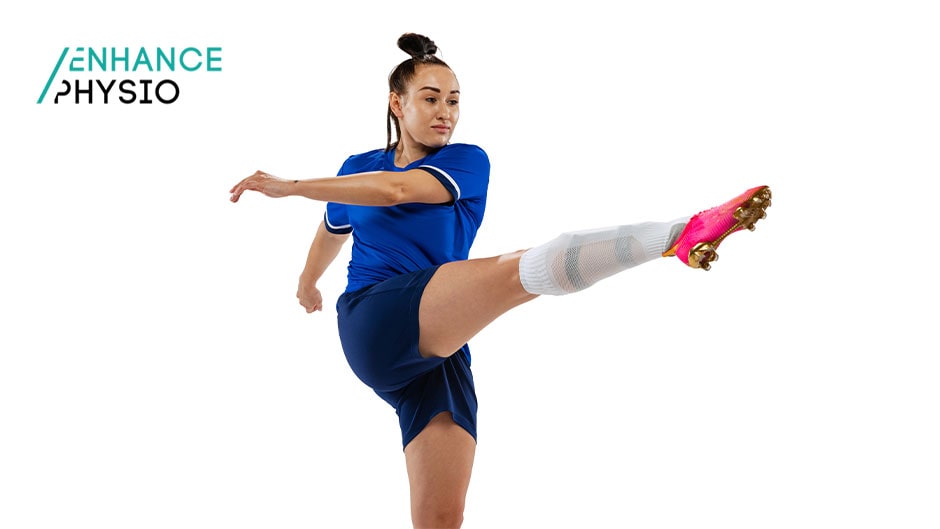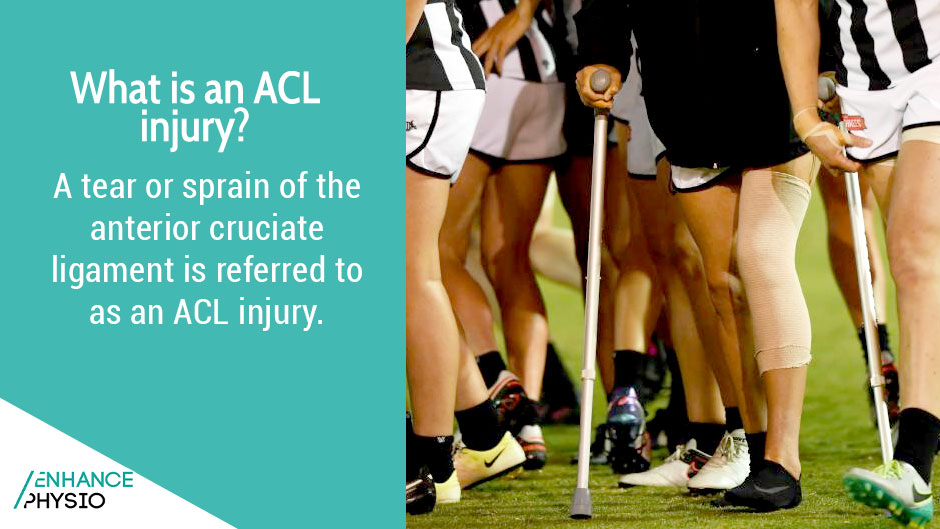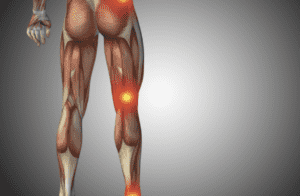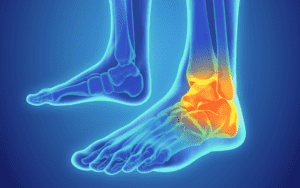Are you a woman who loves playing football but fear that an ACL injury might sideline you? You’re not alone.
Recent water cooler discussions at Enhance Physiotherapy have included ACL injuries in the AFLW competition. We predicted a massive increase in ACL injuries, given that female athletes are x5 more likely to rupture their ACL than males due to structural and hormonal differences.
We have noticed an increase in 15-18-year-old girls with ACL injuries in the clinic. ACL injuries are common in women’s football, but with the help of physiotherapy, you can recover and get back in the game.
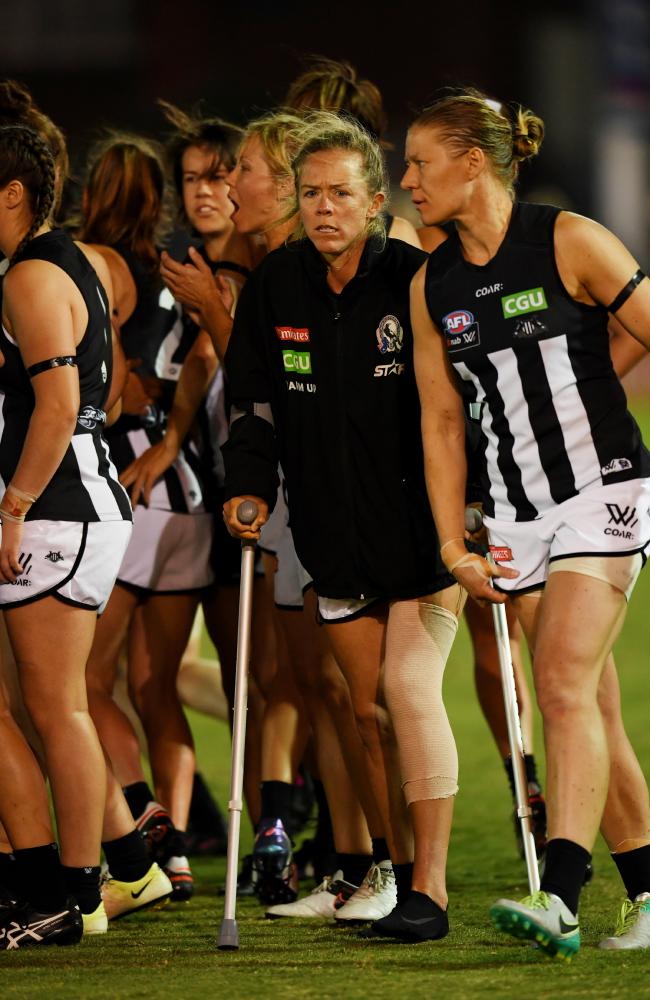
What is the anterior cruciate ligament (ACL)?
Bones, ligaments, tendons, and cartilage make up your knees. The anterior cruciate ligament (ACL) connects the thigh bone (femur) to the shin bone (tibia) and is located in the front centre of your knee.
The four main ligaments located in the knee
- Anterior cruciate ligament (ACL).
- Medial collateral ligament (MCL).
- Lateral collateral ligament (LCL).
- Posterior cruciate ligament (PCL).
The ACL is responsible for stabilising knee movement in both directions. When the leg is straight or slightly bent, the ACL prevents the tibia from sliding or twisting abnormally on the femur.
Furthermore, the ACL keeps the knee from being hyperextended (being stretched or straightened beyond its normal limits).
What is an ACL injury?
A tear or sprain of the anterior cruciate ligament is referred to as an ACL injury.
A tear of the anterior cruciate ligament (ACL) is one of the most feared sports and work injuries, which has ended or derailed numerous high-profile athletes’ careers.
The anterior cruciate ligament is a knee joint supporting ligament that allows for twisting and turning movements. An awkward landing or fall or the impact of a tackle can tear or completely rupture.
A torn ACL is excruciatingly painful and can disable a person for months, if not forever. Immediate diagnosis and physiotherapy treatment can make all the difference in your recovery.
Why are women more susceptible to ACL tears?
An ACL tear can occur at any age, but females are five times more likely than males to have one. Experts are divided on why women are more vulnerable.
Some attribute this to physical conditioning, neuromuscular control, or muscle strength differences. Men tend to activate their hamstrings first, while women tend to activate their quadriceps first. The amount of strain applied to the ACL, and other knee ligaments may be affected by this difference in activation.
Others believe it is due to a difference in pelvic and lower leg alignment, looser ligaments, or estrogen’s effect on a woman’s ligaments.
Differences in how men and women jump and land could also play a role. Women land with their knees closer together than men after a jump. Athletes who land with their knees wider apart appear to be less likely to sustain an ACL injury.
Physiotherapy treatment for ACL injuries
The rehabilitation process after an ACL injury is lengthy and intensive. It is a staged procedure designed to prevent the surgical repair (graft) from failing due to early stressors. Initial treatment usually consists of electrical muscle stimulation, hydrotherapy, anti-gravity treadmill work, and flexibility exercises.
Subsequently, the physiotherapist and rehab team will start with a straight line running and progress to football-specific drills. In the later stages of rehab, pivoting and quick turn exercises are introduced because they place the most strain on the newly repaired ligament.
To reduce the risk of re-injury, it is critical that a physiotherapist closely monitors and advances the player’s rehabilitation throughout the recovery period.
ACL prevention
It is crucial any girls playing AFLW at all levels should be completing an injury prevention program. The program should include strengthening, jumping and landing with correct form and quick pivoting movements to help with the readiness to play.
Santa Monica PEP program
We use several different ACL prevention programs. One of the most straightforward programs is the Santa Monica PEP program.
Warm Up
- Line-to-line jog (1 min)
- Shuttle run (1 min)
- Backwards running (1 min)
Strength
- Walking lunges (1 min)
- Russian hamstrings (1 min)
- Single leg calf raises (1 min)
Plyometric
- Lateral hops over cone (30 secs)
- Forwards/backward hops over cone (30 secs)
- Vertical jumps (30 secs)
- Scissor jumps (30 secs)
Agility
- Forwards run with 3 step deceleration (1 min)
- Lateral diagonal runs (3 passes)
- Bounding run for 50m
Stretching
- Calf stretch (30 secs x2)
- Quad stretch (30 secs x2)
- Hamstring stretch (30 secs x2)
- Adductor stretch (30 secs x2)
- Hip flexor stretch (30 secs x2)

Final thoughts on Physiotherapy For ACL Injuries In Women’s Football
To learn more about the ACL and its associated knee ligaments, Dr Jeremy Kolt sat with local orthopaedic specialist Dr Nathan Smith to discuss all things ACLs.

